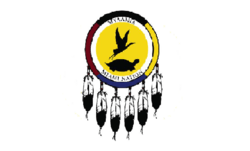Miami Tribe of Oklahoma facts for kids

Miami Tribe of Oklahoma flag
|
|
| Total population | |
|---|---|
| 3,908 | |
| Regions with significant populations | |
| United States (Oklahoma) | |
| Languages | |
| Myaamia, English | |
| Religion | |
| Christianity, traditional tribal religion | |
| Related ethnic groups | |
| Peoria, Kaskaskia, Shawnee people, Wea, Illinois, and other Algonquian peoples |
The Miami Tribe of Oklahoma is a Native American tribe. It is the only federally recognized Miami tribe in the United States. The tribe's name in their own language is myaamionki noošonke siipionki. This means "Miami homelands along the Neosho River."
The Miami people are descendants of those who lived in what is now Indiana, Michigan, and Ohio. In the 1800s, they were moved from their traditional lands.
Contents
Language and Culture
Speaking the Myaamia Language
The Miami Tribe traditionally spoke the Miami-Illinois language. This language is part of the Algonquian languages family. Today, only a few tribal members speak it.
The tribe works with Miami University to bring their language and culture back to life. This partnership created the Myaamia Center. The Myaamia Center studies the Miami language and culture. They use old records, like an Illinois-French dictionary, to help. This research helps tribal members learn and use their language again.
Miami Traditions and Events
The Miami Tribe holds an annual powwow in late June. A powwow is a gathering for Native American people to dance, sing, and socialize. They also have a stomp dance every winter in late January.
The Myaamia Center helps the tribe keep their culture strong. They work on projects to make sure Miami traditions continue.
How the Tribe is Governed
Tribal Headquarters and Membership
The main office for the Miami Tribe is in Miami, Oklahoma. There are 3,908 enrolled members in the tribe. About 775 of these members live in Oklahoma.
To join the tribe, you must show that you are a direct descendant of a Miami person. The tribe does not use a "blood quantum" rule. This means they do not require a certain percentage of Miami ancestry.
Tribal Leadership and Services
Douglas Lankford is the Chief of the Miami Tribe of Oklahoma. The tribe has its own government. They issue special vehicle tags for tribal members. They also run a housing authority to help members with homes.
The tribe publishes a newspaper called Aatotankiki Myaamiaki. It comes out four times a year. The Miami Tribe is building a new place called the Myaamia Complex. This building will help tribal elders. It will also house the tribe's food program and library.
Economic Growth
Businesses and Services
The Miami Tribe has created Miami Nation Enterprises. This group helps the tribe develop businesses. These businesses create jobs and income for the community.
Some of their companies include:
- Miami Business Services: This company provides staff, computer services, and office supplies.
- Miami Designs: They create graphic art and promotional items.
- Miami Cineplex: This is a movie theater and arcade.
- TSI Global Companies: This company works with audiovisual systems, security, and electrical work.
The tribe also owns a smokeshop and two casinos. These casinos are called Prairie Sun and Prairie Moon. The tribe's businesses bring in an estimated $16.7 million each year.
Miami History
Early Life and Society
The Miami Tribe of Oklahoma is an Eastern Woodlands tribe. They traditionally spoke the Miami-Illinois language. The name 'Miami' comes from Myaamia, which is what the tribe called themselves. It might mean 'downstream people'.
Some people thought the Miami called themselves Twightwee. This name was thought to sound like the sandhill crane, a bird important to them. However, studies show Twightwee came from another tribe's name for the Miami. The Miami also call themselves Mihtohseeniaki, meaning "the people."
Miami society was organized into clans. Clans are groups of families who share a common ancestor. Chiefs, who inherited their positions, led these clans. The Miami followed a patrilineal system. This means family ties and inheritance passed through the father's side. Children belonged to their father's clan. Clan mothers were also very important. They had to approve the hereditary chiefs.
The Miami built villages with long houses. Many related families lived together in these longhouses. They were farmers and grew a special type of white corn. For fun, they played games like double ball, the moccasin game, and darts.
Challenges and Rebuilding
In the late 1800s, the Miami faced big changes. The Dawes Act broke up their shared tribal lands. Land was given to individual families. The idea was to make them farmers. But this led to the loss of much tribal land. People took advantage of the Miami. The Curtis Act of 1898 also ended the tribe's government. The federal government took over managing tribal affairs.
Despite these challenges, the Miami Tribe survived. In the 1930s, they reorganized their government. This happened under the Oklahoma Indian Welfare Act. They created their own constitution on August 16, 1939. This set up a government with elected leaders.
In 1996, the tribe changed its constitution. This allowed any descendant of people on certain historical lists to join. Since then, many Miami people living in Indiana have become members. Today, the Oklahoma-based Miami tribe has about 5,600 enrolled members.
In 2014, the tribe asked the U.S. government to officially end an old charter. This charter was from 1940. The tribe had not been using it for many years. The government agreed to their request.
In 2015, the Miami Tribe of Oklahoma opened a cultural office in Fort Wayne, Indiana. This office helps tribal members who live in Indiana. The Miami Tribe of Oklahoma also has strong ties with Miami University in Ohio.
Notable Tribal Members
- Daryl Baldwin, known for language revitalization efforts
- Katrina Mitten, a talented beadwork artist

